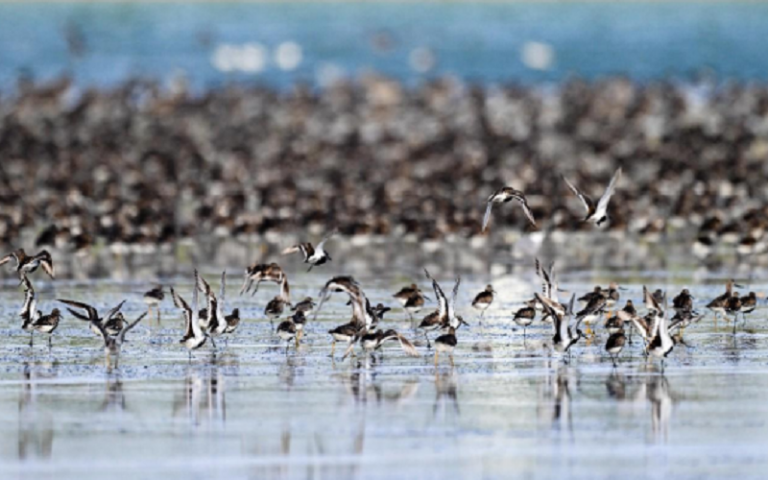
By Wen Cheng, Five nominated sites of the Migratory Bird Sanctuaries along the Coast of Yellow Sea-Bohai Gulf of China (Phase II) were included as a serial extension of the property of the same name already listed on the World Heritage List by the United Nations Educational, Scientific and Cultural Organization (UNESCO).
The decision was made during the 46th session of the UNESCO World Heritage Committee held in New Delhi, India.
The newly admitted five sites were an estuarine wetland in Chongming, Shanghai; the Yellow River estuary in Dongying, Shandong province; a wetland area in Cangzhou, Hebei province; a national-level nature reserve in Dalian, Liaoning province as well as the Yalu River estuary in Dandong, Liaoning.
The Migratory Bird Sanctuaries along the Coast of Yellow Sea-Bohai Gulf of China is located in the world’s largest intertidal wetland, serving as an important habitat for migratory birds along the East Asian-Australasian Flyway.
This migration route stretches from Siberia-Alaska, passing East Asia, Southeast Asia, and South Asia before reaching all the way to Oceania. Spanning 22 countries, it’s the flyway with the richest bird diversity and the highest proportion of endangered species in the world. It provides indispensable breeding grounds, resting places, and wintering grounds for tens of millions of waterbirds.
Since the application to inscribe the Migratory Bird Sanctuaries along the Coast of the Yellow Sea-Bohai Gulf of China on the World Heritage List was made, the populations of several endangered bird species that use this region for seasonal stopover or breeding have remained stable or increased.
In particular, species such as the Siberian crane, oriental white stork, black-headed Gull, and Chinese crested tern, which heavily depend on habitats within China during certain stages of their life cycle, have almost doubled in numbers during this period.
The Migratory Bird Sanctuaries along the Coast of Yellow Sea-Bohai Gulf of China is located in a region along the Chinese coast that is economically developed and densely populated. It is surrounded by vast farmland and fish ponds, emerging towns, busy international waterways, and significant green energy infrastructure. It can be said that this is a World Heritage Site where humans and wildlife live side by side, and where the connection between humans and birds is palpable.
In 2021, a project aiming to restore bird habitats conducted in the first phase of the migratory bird sanctuaries in Yancheng, east China’s Jiangsu province was listed as one of the “100+ Biodiversity Positive Practices and Actions Around the World” together with other 18 initiatives at the 15th meeting of the Conference of the Parties to the Convention on Biological Diversity (COP15).
In 2022, the 2nd Cycle of UNESCO World Heritage & Sustainable Tourism Programme – Chinese Pilot Studies was launched in Badou village located in the Tiaozini wetland of Phase I sanctuaries in Yancheng. Badou village was thus recognized as a base for coordinated world natural heritage conservation and community development.
The Phase I sanctuaries in Yancheng are currently leveraging ecological governance, study tours, and sustainable agriculture to organically integrate the ecological system within the heritage site and the socio-ecological system outside of it. This, in turn, will promote harmonious coexistence between humans and nature, based on the foundation of sustainable socio-economic development.
The Migratory Bird Sanctuaries along the Coast of Yellow Sea-Bohai Gulf of China will likely become a platform for shaping a new paradigm in the relationship between humans and nature.
Traditionally, most natural heritage sites were located in the upper reaches of water systems, where the inhabitants primarily played the role of guardians. However, the Phase I sanctuaries in Yancheng and the three estuary-type heritage sites included in the second phase of the Migratory Bird Sanctuaries along the Coast of Yellow Sea-Bohai Gulf of China are all situated at the terminus of water systems.
Water systems are like veins, and freely flying birds are like cells. They closely connect heritage sites with surrounding farmland, fish ponds, and towns. From an ecological perspective, even those strictly protected core areas form an organic “community of life” with the broader systems upstream of heritage sites.
In this kind of relationship, heritage conservation is not just the responsibility of a small group of “guardians,” but rather an obligation of the broader community in the region – ideally, it should also become a way of life for the people. This means that more people will have the opportunity and necessity to participate in the conservation of heritage sites.
The pilot and demonstration projects already initiated in Yancheng will provide valuable experiences for other regions.
How can people effectively manage the ecosystems around them, like protecting and managing the Migratory Bird Sanctuaries along the Coast of Yellow Sea-Bohai Gulf of China, by utilizing their own wisdom and proactivity? When we can successfully address this question, we will be able to tackle many global ecological issues. The Migratory Bird Sanctuaries along the Coast of Yellow Sea-Bohai Gulf of China provides us with a unique platform for such practical endeavors.
(Wen Cheng is a member of the National Forestry and Grassland Administration’s World Heritage Expert Committee. He has been offering technical support for the application to inscribe the Migratory Bird Sanctuaries along the Coast of the Yellow Sea-Bohai Gulf of China on the World










